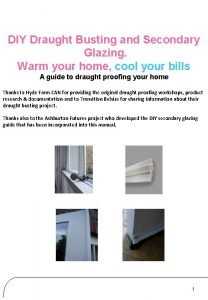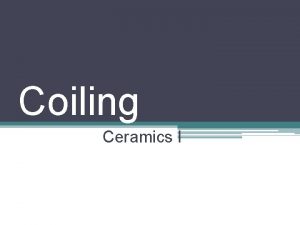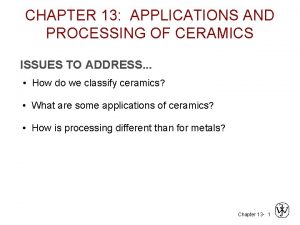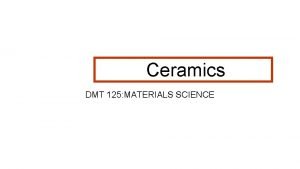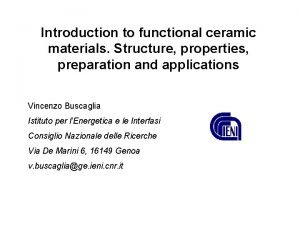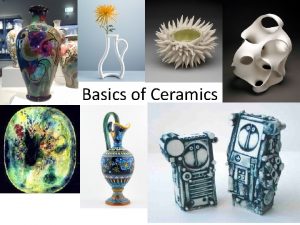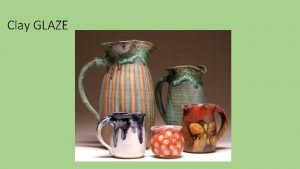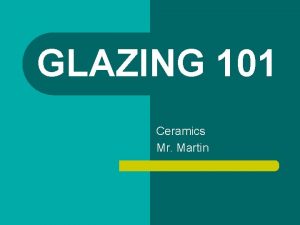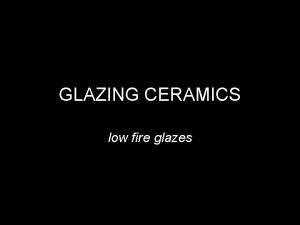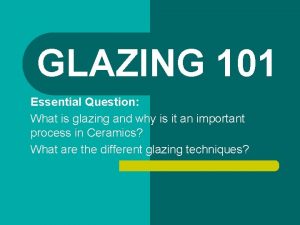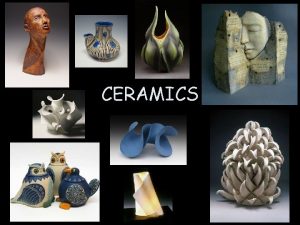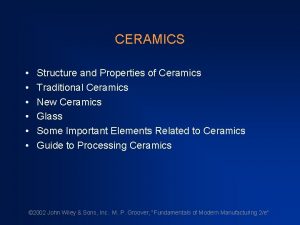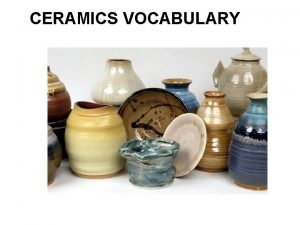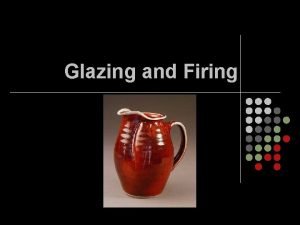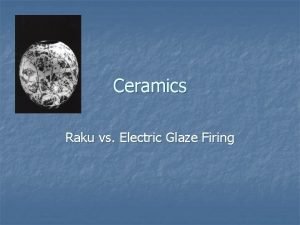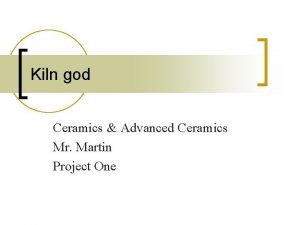GLAZING 101 Ceramics 1 GLAZE IS l A

















- Slides: 17

GLAZING 101 Ceramics 1

GLAZE IS… l A liquid suspension of finely ground minerals which is applied on the surface of bisque fired clay. l The glaze ingredients will melt together when fired to form a glossy glass-like surface.

What is in glaze? l l l Silica- the glass former (Refractory) Alumina- the portion that ‘shrinks-to-fit’ the clay. Flux- lowers the melting point of higher temperature ingredients.

GLAZE l The purpose of a glaze is to: – 1. Decorate or add color to a ceramic piece. – 2. Waterproof a ceramic object. A clay body should be glazed in order to seal pores and make it water-tight. l Glazing is generally done by brushing, pouring, dipping or spraying.

GLAZE Many different colors are possible using minerals and elements as a basis for colorant. The color of the liquid glaze IS NOT necessarily the color it will be when fired. (Check glaze chart or color tiles for an idea of glaze color) When firing, the objects should be placed about ¼” apart and from the sides of the kiln to prevent the two surfaces from bonding together.

CLAY FOR DECORATING l The color and texture of clay will have a great impact on the glaze. l A light colored clay will have a better color response. l The texture of the clay surface can make a nice contrast in the over-all effect of glazing. l Glaze in a way to enhance the design of your work, not detract from what should be a well-planned project.

Can we mix any two glazes together? “They’re Minerals, Marie!” l Most of the time, it will not work. Glazes are not like paint; they're minerals in a water suspension. It depends on what the minerals are that you're mixing, and how they will combine together as they turn into glass in the heat of the kiln. For Example: If you mix yellow and blue paint, you'll get a green of some sort. But if you mix a yellow and a blue glaze, you have no such guarantee. You're just as likely to get black, brown, or a bubbled beige as you are to get green. Underglazes are a different matter. They are pigmented clay slips. You can mix them like paint, most of the time. The fired result will turn out just as is seen.

GLAZING RULES There rules that need to be followed to help us be successful.

RULES FOR GLAZING ** Glaze is expensive, glaze only those works you plan to keep. l 1. Rinse off your bisque pieces to remove any oxidation, dust or clay particles. (Glaze will not stick to loose foreign matter. ) – l Defects from glazing: Blistering, pinholes, crawling, running, cracks and dull sheen to name a few. 2. Remove rough spots before glazing. (No sanding of pots inside building if possible. Go outside if sanding is necessary. )

RULES FOR GLAZING l 3. Be especially careful not to contaminate one glaze with another. l 4. Wipe off lids and replace them on glaze containers immediately after using. (Make sure you put the correct lid on the correct glaze container! ) Also, do not use the same contaminated brush with different glaze jars.

RULES FOR GLAZING l 5. Check labels, some still contain a small amount of lead which can not be used for holding food or drink. They also can not be sprayed. l 6. After glazing your pieces, clean up drips on tables and floor. l 7 a. WORK CLEAN - Clean off any glaze that sticks to the foot of the clay piece. Bottoms of pots must be absolutely free of glaze or the pot will not be fired.

RULES FOR GLAZING l 7 b. WORK CLEAN - “Dryfoot” all glazed objects prior to firing. Wipe all glaze ¼” above the bottom of the piece. l 7 c. WORK CLEAN- In lieu of “dry footing, ” the bottoms of many pieces can use a wax resist method. Wipe off any glaze that beads on the wax. Wax is not a guarantee. l 7 d. Be sure to spray water through the airbrush when finished. Glaze will set-up in the tubing and make problems in the future.

STIR, STIR l l l When a glaze settles out, some of the heavier components of the glaze settle to the bottom of the container. If you try to use this glaze without thoroughly remixing you will be applying a glaze with key ingredients missing. Glaze should be of ‘Milkshake’ consistency. Add minimal amounts of water if it is too thick.

ADVICE l So that the decoration works as a whole with the ceramic piece and that it looks convincing, plan your approach to materials and how to apply them right from the beginning. l Often, a piece can be PAINTED with acrylic paints. There are many more choices of colors when using paints.

DECORATION TECHNIQUES l l l l l Stencil - stippling Wax Resist Use of Oxides in combination with glaze Spraying Combing Banding Trailing Scraffito IF you want to try some advance glazing techniques, ask for some help.

CAUSES OF DEFECTS l BLISTERS AND PINHOLES: – l BLISTERS IN THE CLAY: – l A second glaze was applied over a completely dry first coat. CRAWLING OR SCALY SURFACE: – l Caused by bisque not being moistened before glazing. Glaze trapped in the pours of the clay. Dust or oil on the clay surface. RUNNING GLAZE: – Glaze was applied too heavily.

CAUSES OF DEFECTS (cont. ) l CRACKS IN THE GLAZE: – l Glaze applied too heavily – the glaze will pull apart at the cracks when fired. POOR SURFACE OR DULL SHEEN: – Glaze applied too thin.
 Ceramics 101
Ceramics 101 Things made of ceramics
Things made of ceramics Prueba isocronal modificada
Prueba isocronal modificada Secondary glazing diy
Secondary glazing diy Why listening is an active process
Why listening is an active process Conclusion of pottery
Conclusion of pottery Superconductor ceramics
Superconductor ceramics Coiling definition art
Coiling definition art Die blanks ceramics
Die blanks ceramics Abstract expressionist ceramics
Abstract expressionist ceramics Hand building ceramics definition
Hand building ceramics definition Ceramics def
Ceramics def Greek beads keramos
Greek beads keramos How are piezoelectric ceramics made
How are piezoelectric ceramics made Greenware ceramics definition
Greenware ceramics definition Score definition ceramics
Score definition ceramics Recent advances in dental ceramics
Recent advances in dental ceramics Particulate forming process in ceramics
Particulate forming process in ceramics



